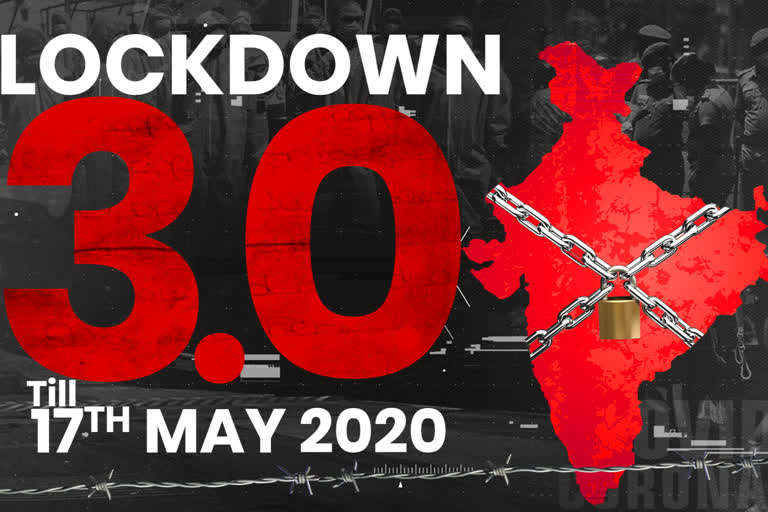New Delhi: The third phase of the countrywide lockdown begins Monday with 'considerable relaxations', but curbs will continue in containment areas so that the gains achieved so far in the fight against COVID-19 are not 'squandered away', officials said Sunday.
The country has been divided in three zones -Red, Orange and Green - based on coronavirus risk-profiling. The extended lockdown is slated to last till May 17.
According to the Home Ministry, activities prohibited throughout the country, irrespective of the zones are: air, rail, metro travel; inter-state movement by road; schools, colleges, and other educational, training and coaching institutions; hospitality services, including hotels and restaurants.
Places of large public gatherings -- cinema halls, malls, gymnasiums, sports complexes -- social, political, cultural and other kinds of gatherings and religious or public worship places are in the prohibited list.
However, movement of individuals for non-essential activities in all zones, barring containment areas, is allowed but strictly between 7 am and 7 pm.
Barber shops, spas and salons in Green and Orange zones is allowed to open as is the sale of non-essential items by e-commerce firms.
Sale of liquor will be allowed with certain conditions in all zones, barring containment area, in standalone shops, not in markets or malls.
Sale of liquor, barber shops and salons were not allowed during the first two phases of lockdown. when sale of non-essentials by e-commerce companies was also not allowed.
In all zones, persons above 65 years of age, those with underlying health conditions, pregnant women, and children below 10 years shall stay at home, except for essential and health purposes.
Movement of people by air, rail and road is allowed for select purposes, and for purposes as permitted by the MHA. In containment areas, movements of people is totally banned and essential services are delivered at the doorsteps.
The list of permitted activities also include: OPDs and medical clinics in all zones with social distancing norms and other precautions. However, these will not be permitted in containment zones.
All goods traffic will be permitted and no state or UT shall stop the movement of cargo for cross land-border trade under treaties with neighbouring countries.
In Red zones (outside the containment areas), some additional activities are prohibited: plying of cycle rickshaws and auto-rickshaws, taxis and cab-aggregators; intra-district and inter-district buses; barber shops, spas and saloons.
Certain other activities have been allowed in the Red zone with restrictions: Movement of individuals and vehicles for permitted activities with a maximum of 2 persons (besides the driver) in four-wheelers, no pillion rider on two-wheelers.
In Red zones, e-commerce companies are allowed to sell only essential commodities. Barber shops and salons are not allowed to open.
In all liquor shops, customers will have to maintain a minimum six-feet distance (2 gaz ki doori), and no more than five persons allowed at one time.
On domestic helps in red zones, resident welfare associations should take a call on allowing in outsiders.
If allowed by RWAs, health protocols have to be maintained by the domestic helps and employers, and the responsibility lies with the person who employs maids in case of any mishappening.
Industrial establishments in urban areas, like Special Economic Zones (SEZs), Export Oriented Units (EOUs), industrial estates and industrial townships with access control have been permitted from Monday in all zones, except containment areas.
Private offices can operate in red zones with up to 33 per cent strength with the remaining persons working from home.
In Orange zones, all activities permitted in red zone (outside containment zone) and taxi and cab aggregators (driver with 2 passengers only) are allowed.
Inter-district movement of people and vehicles for permitted activities, 4 wheelers with 2 passengers besides driver, pillion riding on 2 wheelers are allowed. However, inter and intra-district movements of buses, except those permitted by the MHA, is prohibited.
In Green zones, all activities are permitted except the ones prohibited throughout the country, irrespective of the zone.
However, buses can operate with upto 50 per cent seating capacity and depots too at 50 per cent.
A district is considered in 'Green' zone if there are no confirmed cases so far or there has been no reported case for the past 21 days.
According to the health ministry, as on Friday, there were 130 'Red' zones, maximum of 19 in UP, followed by 14 in Maharashtra. The number of 'Orange' Zones was 284 and 'Green' was 319.
All the districts of the national capital have been put under 'Red' zone.
Other activities allowed outside containment areas of a Red Zone (with restrictions) in urban areas are: manufacturing of essential goods like drugs, medical devices and their supply chain, manufacturing of IT hardware, jute industry, construction (if workers residing on site).
Operations of homes for senior citizens, children, destitute etc., government offices, and emergency, health, sanitation and security services.
In rural areas: industrial and construction activities; agriculture, animal husbandry and plantation, financial sector including banks, NBFCs, public utilities, courier and postal services; media; IT, ITeS, warehouses services by self-employed persons, except barbers.
States and UTs may put certain restrictions based on their assessment.
PTI REPORT
Also, read: How Koyambedu vegetable market turned into COVID-19 hotspot of Tamil Nadu!



